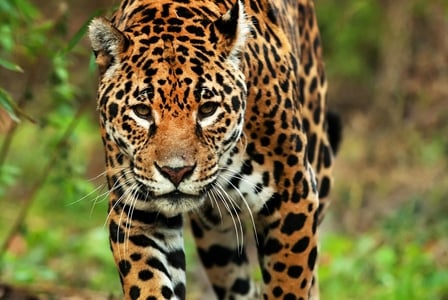
These spotted predators are the largest cats in the Western hemisphere – so it comes as no surprise that people have been fascinated by them for centuries.
These spotted predators are the largest cats in the Western hemisphere—so it comes as no surprise that people have been fascinated by them for centuries. On this Wildlife Wednesday, we learn about jaguars.
Habitat
Jaguars can be found throughout Central and South America, ranging from Brazil and Peru to Argentina, Guatemala, Mexico, and even the US.
Trivia
- Jaguars get the bronze medal in the “World’s Largest Cat” category—they weigh up to 300 lbs (136 kg), earning them third place behind tigers and lions.
- Unlike some cats, however, jaguars aren’t picky about what they eat. Researchers have found as many as 85 different species that show up in these oversized cats’ diets, including deer, tapirs, cattle, small alligators, turtles, fish, and rodents.
- As the only big cat found in Central and South America, jaguars play a huge role in native folklore there. In Maya culture, the lord of the underworld was thought to be a jaguar, while the B’alams were jaguar gods who protected people throughout their day-to-day life.
- While jaguars do bear an uncanny resemblance to their feline cousins the leopard, there are a few ways to tell them apart. For one, jaguars are more heavily built. For another … leopards live on the other side of the planet.
- Those spots that jaguars so proudly sport? They’re called rosettes and, on some cats, the overall colour of their fur becomes so dark that these black marks become nearly invisible—meaning panthers and jaguars are actually the same animal!
Why are they threatened?
Like many of their large feline cousins, jaguars face a number of threats caused by humans; deforestation and habitat degradation due to forestry, mining, and farming isolates jaguar populations, and farmers may shoot the big cats on sight because they’re considered to be a threat to livestock. Beyond that, jaguars also have to compete with people for prey.
Commercial hunting is also a concern, but the good news here is that it’s dropped dramatically since the mid-1970s, when legislation and anti-fur campaigns greatly reduced international demand. Jaguars are also protected over much of their current range, making hunting and trapping illegal in most nations and severely restricted in Brazil, Costa Rica, Guatemala, Mexico, and Peru.


